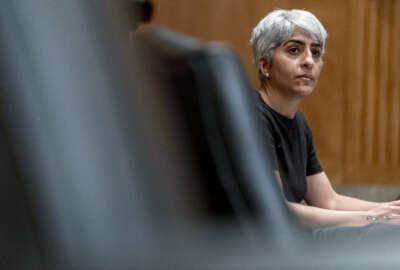What will the future federal workplace really look like?
The federal workplace has been an improvisational theatre. It's time to start creating a final version.
Little good has come of the delta variant. But it bought time for companies and government to tug at a Gordian Knot of what the return to the workplace should look like.
No one has figured it out yet.
As Jason Miller, the White House point man on management, pointed out in an interview yesterday on Federal Drive with Tom Temin, some 40% of federal employees never did telework in the first place. Air traffic controllers, Border Patrol agents, letter carriers, lab animal caretakers, forest rangers — those are just a few of the job categories for whom the term “telework” has no meaning.
An estimated 59% of feds did go to full-time telework, or something like, when the pandemic hit. That’s up from 3% who regularly teleworked pre-pandemic. Miller said there’s no way that number will drop back to 3%, because the model of what constitutes normal work habits is itself changing. And fast.
The Office of Budget and Management and Office of Personnel Management people know the basic notion of where you work has changed. It’s going to be somewhere between these two poles.
First, there’s the “boomer” model of work — and I note that boomers mostly say it was the oldsters before them that had this model. You traipsed in to the office 9-5 Monday-through-Friday for a few decades. You occupied whatever space you were assigned, whether cubicle or mahogany-veneer office with GSA-issued brasstone lamp. You did your thing, made your TSP contributions, paid the mortgage.
I know, I’m drawing with an 8-pack of Crayola. But I’m making a point.
At the other end of the model is that of Generation Z. You know, the kids that think they know everything, and are therefore entitled to work when they want, where they want, and how they want. While also having no compunction about telling you how to manage and set priorities. In the private sector they expect stock options, profit sharing, cold brew coffee on tap, and the right to air grievances on social media. These are people whose baby carriages cost more than their grandparents’ first Gremlin.
Granted, these are cartoonish extremes. But they show the range of attitudes and styles agencies must somehow cope with. In reality, people are of mixed minds.
Folks accustomed to office work in the office would like the company of colleagues. But no one wants to commute in obnoxious traffic or on Metro rail with the wheels falling off. Z-ers may say the workplace is where a person happens to be. Yet they fret about getting hired somewhere and never actually meet the people they work with.
Agencies have installed the technology they need to issue credentials and computers to people. Many order machines, have the supplier image them, and then ship them to people’s houses. Agencies have licked the practical barriers to remote work. The real issue is how to fashion a hybrid and fair work model.
On a panel I moderated for the George Mason University, Josh Wilson, a senior vice president at LMI, described one possible model. The office, he said, will become a place to convene. He called it the new off-site. Complete with that cold brew. Employers will want to cut their real estate but jazz up the remaining convening spaces. That means people will ordinarily work remotely, presumably from home.
Another possibility: People pick their telework days, and — what is that word? — “hotel” it when they go to the office. With fewer desks than employees, the schedules would need regulatory and tight enforcement. This model has the virtue of incorporating several wants. People could work at home more. Rush hour traffic would be permanently, if only partially, alleviated. The government could confidently trim the office space it rents. Government would become a more attractive option for Little Cats X, Y and Z.
Whatever form reentry will take, the deciders need to get on with it. I mean the Safer Federal Workforce Task Force. It’s motto: “Helping to ensure all federal employees, contractors, and visitors can safely work together.” This seems like the right group for the job. Most of the group’s work has been improvisational. Updates have come nearly weekly for agencies and contractors. Deadlines keeps moving. That’s understandable.
What people connected to the federal workforce need now, though, is a clear picture of the eventual permanent model.
Nearly Useless Factoid
By Alazar Moges
The most popular baby name for a girl in 2020 was Olivia, and for a baby boy it was Liam.
Source: Social Security Administration
Copyright © 2025 Federal News Network. All rights reserved. This website is not intended for users located within the European Economic Area.
Tom Temin is host of the Federal Drive and has been providing insight on federal technology and management issues for more than 30 years.
Follow @tteminWFED






